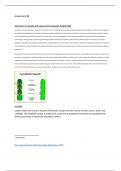Assignment 8B
Structure of vessels and valves that transport lymph fluid
Lymphatics' general organization is based on that of blood arteries. Endothelial cells, a subtype of epithelium known as the endothelium, make up the inner lining of
the single flattened epithelial cells that make up the simple squamous epithelium. As the basement membrane on which it rests is discontinuous, this layer, which is
used to mechanically move fluid, leaks quickly. The smooth muscles, which are organised in a circle around the endothelium, are the next layer. By shortening
(contracting) or relaxing, these muscles change the diameter (calibre) of the lumen. Adventitia, which is made up of fibrous tissue, is the top layer. Only larger
lymphatics exhibit the broad organization described here; smaller lymphatics have fewer layers. The muscle layer and the outer adventitia are absent from the tiniest
vessels (lymphatic or lymph capillaries). They enlarge and initially acquire adventitia, then smooth muscles, as they move forward and are joined by other capillaries
along the way.
The majority of lymph vessels are thinner than 1 mm (or 0.04 in). The lymphatic system lacks a central pump and is not closed like the cardiovascular system. Due to
peristalsis—the propulsion of the lymph caused by the alternate contraction and relaxation of smooth muscle—valves, compression during the contraction of nearby
skeletal muscle, and arterial pulsation—lymph movement occurs despite low pressure. The heart is a pump that creates a force to propel the movement of lymph
fluid, but lymph arteries lack this structure and have no pump. Lymph vessels are not a circuit; rather, they are blind ended tubes with a start and a finish. As they
have such low pressure, they have two valves to avoid backflow. Capillaries are the body's tiniest lymphatic veins1.
2
Location
Lymph vessels are found in all parts of the body, except from the central nervous system, teeth, and
Cartlidge. The lymphatic system is made up of a network of lymphatic vessels that run parallel to the
blood vessels that comprise the circulatory system.
1
class notes
2
Pin on Nursing School and Study Guides (pinterest.ca) 23/2
, 3
Function
Lymph vessels carry lymph and form the basis of the lymphatic system, they deliver lymph into the
blood at junctions, for example into the subclavian vein. Lymph vessels Return the interstitial fluid and
proteins from around the cells in the form of lymph back to the blood. They Deliver the lymph to the
lymph nodes, which remove foreign particles, microbes, and cancer cells from it, and they transport
lymphocytes from one node to another, as well as they Transport the chyle which is a mixture of the
lymph and chylomicrons (made of triglycerides, cholesterol and protein absorbed from food in the small
venous blood) to the gut. 4
Along with the rest of the system, lymphatic veins help maintain the body's fluid balance, absorb lipids
from the digestive tract, and provide immune defence against pathogens and disease. Problems like
lymphedema and the spread of cancer cells might result from impairment in these processes. Fluid
surrounds tissue cells when blood circulates and seeps out of blood capillaries. Interstitial fluid is the
term for the liquid that surrounds the cells. The cells receive oxygen and nourishment from this fluid.
Some of the fluid is left behind, but the majority returns to the bloodstream. The residual liquid, which is
now known as lymph, is absorbed by lymphatic capillaries.
The subclavian vein is where the lymphatic system returns the lymph to the bloodstream after it has
been transported. This fluid balance is essential. Maintaining blood pressure and avoiding edoema are
made possible by removing interstitial fluid at the same rate it is created (swelling in the tissues). The
small intestine is where nutrients from the digestive tract are absorbed. Villi, which resembles hairs,
covers the lining of the small intestine. Each villus has lymphatic and blood capillaries in the middle.
Most nutrient absorption occurs in blood capillaries. Nonetheless, lacteals, specialized lymphatic
capillaries, absorb fats and fat-soluble vitamins (vitamins A, D, E, and K). The vitamins and lipids are
given through the lymphatic system once they have been absorbed. As lymph moves down the
lymphatic pathway, it passes through bean-shaped organs known as lymph nodes. Filtering the lymph
and eliminating any germs or damaged (perhaps malignant) cells are the duties of lymph nodes. Immune
cells like lymphocytes are found in lymph nodes. When a pathogen is found in the lymph, lymphocytes
proliferate and go towards the infection site to assist in eradicating the invader. The enlarged lymph
nodes you may encounter while unwell are caused by lymphocytes that have been activated. 5
3
What Are the Components of the Lymphatic System? (thoughtco.com) 23/2
4
class notes
5
Lymphatic Vessels: Anatomy, Function, and Treatment (verywellhealth.com) 23/2/23
, 6
lymph nodes
At various points along their path the vessels join with a knot of tissue called a lymph node (also called a
lymph gland). These nodes are found around major arteries and you can feel them: In your neck, armpits
(axillary nodes) and groin (inguinal nodes) At the back of your knee (popliteal nodes) Above your elbow
on the inner side of the upper arm (supratrochlear nodes) where arteries run close to the body surface
There is also a ring of lymph nodes (tonsils and adenoids) circling the esophagus and airways in the
throat region. These are thought to be used for filtering infecting organisms out of food and inhaled air.
In the lymph nodes, bacteria, cancer cells and other foreign particles are filtered out and ingested by
macrophages. As the fluid leaves the nodes it picks up lymphocytes and some antibodies. Dendritic cells
in lymph nodes trap antigenic material circulating in the lymph and blood and present it to the resident
lymphocytes This causes production of the appropriate T and B cells, which can then mount an immune
response against infecting organisms that have these antigens on their surfaces.
6
Functions of lymphatic system - Biology Notes for IGCSE 2014 (weebly.com) 23/2




